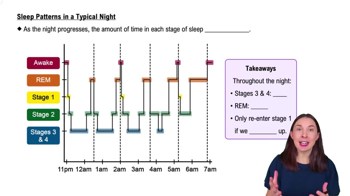Table of contents
- 1. Introduction to Psychology1h 43m
- 2. Psychology Research2h 20m
- 3. Biological Psychology2h 41m
- 4. Sensation and Perception28m
- 5. Consciousness and Sleep32m
- 6. Learning41m
- 7. Memory34m
- 8. Cognition37m
- 9. Emotion and Motivation35m
- 10. Developmental Psychology33m
- 11. Personality48m
- 12. Social Psychology41m
- 13. Stress and Health41m
- 14. Psychological Disorders44m
- 15. Treatment47m
5. Consciousness and Sleep
Sleep
Struggling with Psychology?
Join thousands of students who trust us to help them ace their exams!Watch the first videoMultiple Choice
The level of weight that the body tries to maintain is known as
A
metabolism.
B
the weight set point.
C
the basal metabolic rate.
D
the body mass index.
 Verified step by step guidance
Verified step by step guidance1
Understand the concept of 'weight set point': It refers to the theory that each individual has a genetically determined range of weight that their body will try to maintain.
Differentiate between 'weight set point' and 'metabolism': Metabolism is the process by which your body converts what you eat and drink into energy, not the level of weight the body tries to maintain.
Consider the 'basal metabolic rate': This is the number of calories your body needs to accomplish its most basic (basal) life-sustaining functions, not the weight level the body tries to maintain.
Understand 'body mass index (BMI)': BMI is a measure of body fat based on height and weight, not a mechanism for maintaining weight.
Conclude that the 'weight set point' is the correct term for the level of weight that the body tries to maintain, as it is distinct from metabolism, basal metabolic rate, and body mass index.

 3:25m
3:25mWatch next
Master Circadian Rhythms with a bite sized video explanation from Hannah Gordils
Start learningRelated Videos
Related Practice


































































































![Race, Genes and IQ Differences | Bret Weinstein [Mini Clip]](https://img.youtube.com/vi/IztL_m3pd70/mqdefault.jpg)



































































































